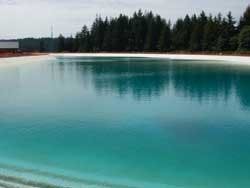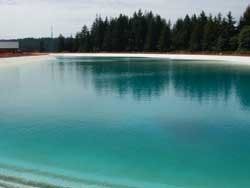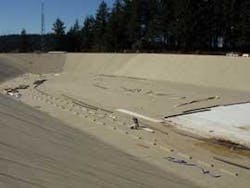Innovative rehabilitation project splits reservoir in two
Drinking water reservoir depends on geotextile membranes designed for exposure to extreme cold and ultraviolet light for 20 years of use in liners and floating covers.
The US$ 16.6-million Franzen Rehabilitation Project, which split a reservoir into two lined cells and provided both sections with floating covers, was completed for the US city of Salem, Oregon in December 2004.
The reservoir was built in the 1950s and holds nearly 100 million gallons of drinking water. Salem depends on 17 other reservoirs, but Franzen is by far the largest, serving 171,000 water customers. It holds water drawn from the North Santiam River and is treated at the city’s Geren Island facility.
The Franzen rehabilitation project reinforced the reservoir’s earthen support structure, splitting the reservoir into two separate lined cells, an east and west cell, and then providing each with a floating cover. The double cell design will provide maximum operational flexibility in that half of the reservoir can be taken out of service for repairs or maintenance while the other half continues to provide water to the city.
The floating covers will protect the water from contaminants such as dust, leaves and other debris, and prevent water loss from evaporation. The US company of Cooley Engineered Membranes of Pawtucket, Rhode Island, manufactures Coolpro®, a special 45-mil reinforced polypropylene membrane, that was used by Colorado Lining International, Inc. to make the reservoir cover and liner.
The City of Salem specified the membrane to be tan on one side and white on the other. For the liner and cover, the white side of the membrane faces the interior of the reservoir, so that a diver’s flashlight reflects the white, making it easier to inspect the reservoir when filled. The city chose the tan colour to blend harmoniously into the woodland area where the reservoir is located.
The success of the project depended upon several functional characteristics. Durability is key to the success of any membrane exposed to the elements. Ultraviolet light, the same light that causes sunburn, can degrade a membrane that isn’t properly protected and stabilised. Cooley’s polymer chemists designed Coolpro with special light stabilisers to ensure the cover will function as intended for 20 years.
Extreme cold can also be problematic. Coolpro is specially formulated to withstand temperatures down to -40°F without cracking. Finally, Coolpro is certified under NSF International (NSF) Standard 61 for potable water containment. Certification followed extensive testing at the NSF laboratories in Ann Arbor, Michigan, USA, and unannounced factory inspections from NSF personnel. Standard 61 certification is a requirement for any application where the membrane will contact drinking water.
A liner is only as good as the subgrade underneath. The general contractor paid particular attention to properly grading the floor and side slopes of the reservoir. A protrusion-free floor, smoothly angled slopes and the “lay flat” characteristics of Coolpro, combined to ensure a virtually wrinkle-free liner. For added protection, a 22-ounce per square yard needle-punched nonwoven geotextile is used as a cushion between the earth floor and the liner. Per site personnel, water tended to weep through the slope on the north side of the reservoir due to a high water table. If not corrected, the slope would become unstable over time. The solution was to install a double-sided geocomposite (6 oz/yd2 nonwoven geotextile heat-bonded to a polyethylene geonet) on the north slope to intercept the water and direct it to a sump.
The properties required for the polypropylene membrane were specified before the project began. Cooley conducted in-house testing and provided certification that the liner met all of the project requirements. The fabricator tested factory-fabricated seams in-house, and tested field seams on-site, with the results compared to predetermined project specifications. In addition, both factory and field seams were sent to an independent accredited testing lab to validate in-house and in-field results.
Once the west cell of the rehabilitation project was completed, having been lined and fitted with a floating cover, water held in the east cell was transferred via connecting pipes to the west cell where it was decontaminated prior to placing the cell in service. The east cell was then lined and fitted with its floating cover. The entire project was completed in December 2004.
Author’s Note
Diane Rose is the marketing coordinator for the Cooley Group, located in Pawtucket, Rhode Island, USA. For more information, visit: www.cooleygroup.com


